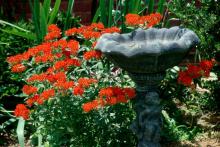Information Possibly Outdated
The information presented on this page was originally released on June 10, 2004. It may not be outdated, but please search our site for more current information. If you plan to quote or reference this information in a publication, please check with the Extension specialist or author before proceeding.
Butterfly weeds look brilliant along roadsides, in gardens
By Norman Winter
MSU Horticulturist
Central Mississippi Research & Extension Center
I made the drive to Aberdeen a few days ago and was amazed at the iridescent orange along the roadside.
There's no missing this bright orange whether you are driving the Natchez Trace or some busier thoroughfare. It also will be noticed by the Monarch butterfly. The plant is the native butterfly weed Ascelpias tuberosa.
Butterfly weed has a large native range and is hardy from zones 3 to 10. The orange flowers will certainly enhance the landscape, but watching what follows over the next few weeks will be something the whole family remembers.
When the Monarchs come to feast on the nectar, you may not even notice them laying eggs that will hatch and turn into colorful caterpillars. These starving creatures literally will strip the leaves and flowers, making the plant look like a pencil cactus.
The caterpillars will grow from tiny to huge in what seems like days. Then about the time you think the plant is dead, new leaves and flowers will appear and you'll notice even more butterflies. Congratulations: you're a proud parent.
If your garden center doesn't have butterfly weed plants for sale, they may have seed packets. You can also collect seeds from plants in mid- to late-summer. Watch closely because the seedpods will split open as they mature, and the seeds will become airborne. Transplanting from the wild is not recommended because they have long taproots and because our wild areas need to keep them.
Growing from seed is simple: the small seeds should be lightly covered with soil that is kept moist until germination. Once planted in the garden, they are considered drought-tolerant and should be watered sparingly but deeply when needed. Fertilizer needs are low -- just give them a light application in the spring with the emergence of new growth.
When you see caterpillars feeding, remember not to spray an insecticide. Instead, create a butterfly garden with the butterfly weed plants in front of buddleias like Empire Blue, Nanho Blue or Black Knight. You'll love the combination planting. Also grow them with Indigo Spires or Victoria Blue salvias, Dark Knight caryopteris and Biloxi Blue verbena.
Believe it or not, there are named selections of the butterfly weed. Gay Butterflies (orange, red and yellow mixed), Orange Flame (orange), Vermillion (red) and Hello Yellow (yellow) are the leading selections.
Occasionally you will find the Asclepias incarnata for sale. This butterfly magnet is known as milkweed and comes in pinks, yellows and whites. The imported Asclepias curassavica, known as bloodroot, often is easy to find at garden centers.
You'll be doubly happy with plants that not only are beautiful, but serve as a food source for butterflies and hummingbirds as well.



